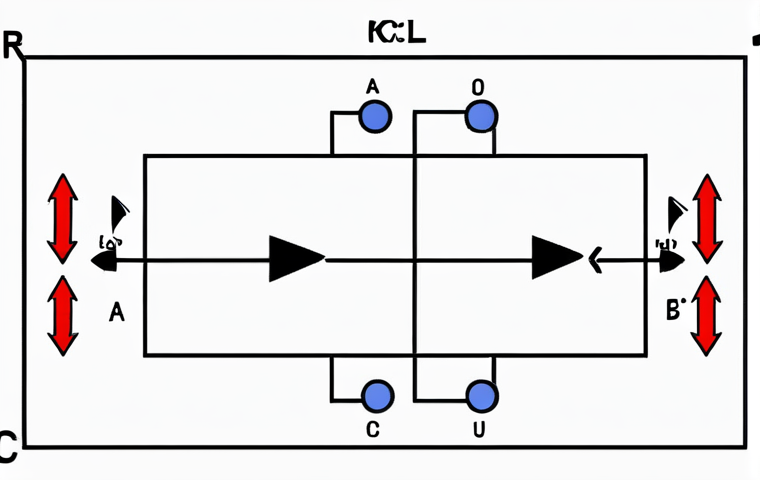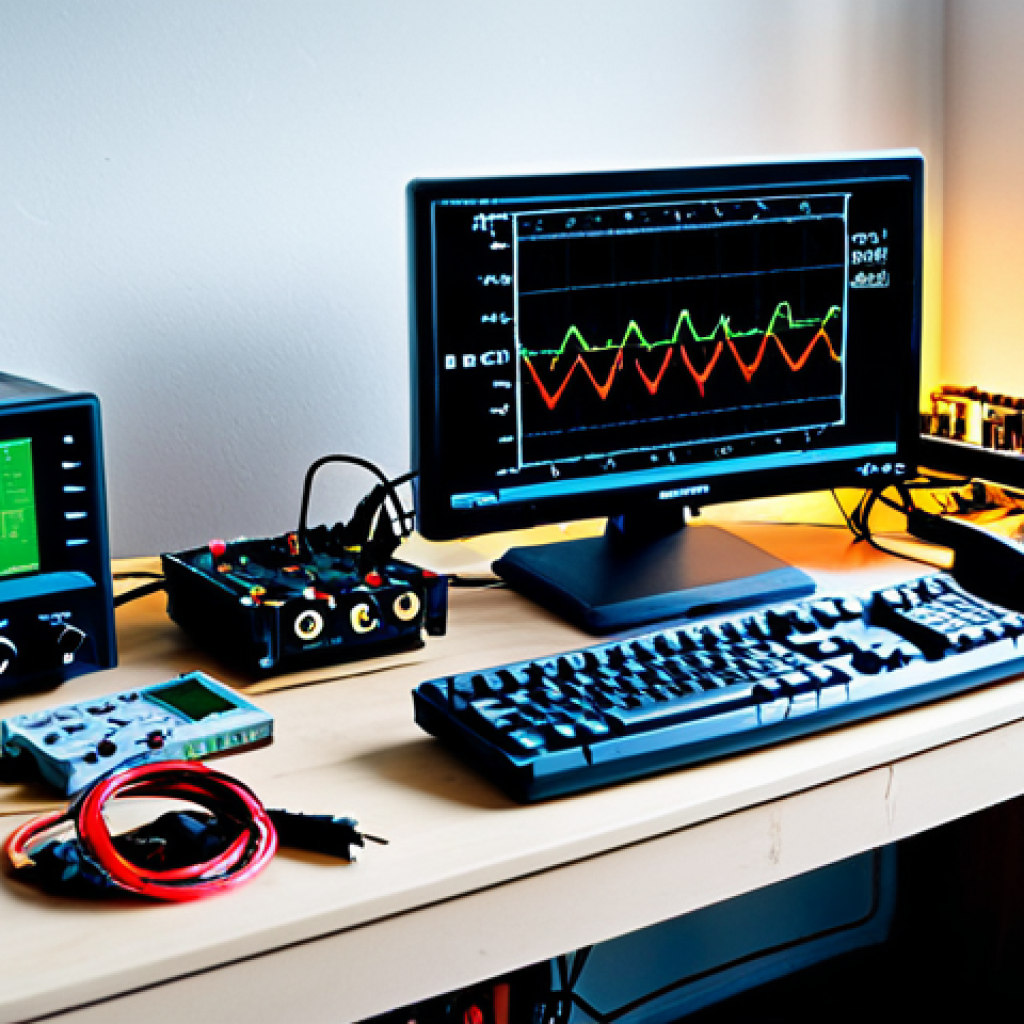Ever wondered how your phone charger knows when to stop charging, or how smart appliances operate so seamlessly? The magic often lies in carefully designed electrical circuits.
As someone who’s tinkered with electronics since childhood, I can tell you it’s more than just wires and components; it’s about understanding the flow of energy and making it work for you.
In recent years, the field has exploded with innovations in energy efficiency and miniaturization, driven by the demands of AI and the Internet of Things.
These advancements are leading to more powerful and efficient devices than ever before. Let’s delve into the fascinating world of electrical circuit design.
We’ll explore the fundamental principles and practical applications shaping our increasingly digital world. I’m excited to share what I’ve learned and show you how these principles can be applied.
Let’s learn more in the article below.
Understanding Basic Circuit Components

Resistors: The Gatekeepers of Current
Resistors, those little striped cylinders, are the unsung heroes of circuit design. They control the flow of current, preventing components from being overloaded.
I remember when I first started tinkering, I blew out a few LEDs because I didn’t understand the importance of resistors. Each resistor has a specific resistance value, measured in ohms, which dictates how much it impedes current.
Think of them like tiny dams in a river; the higher the dam (resistance), the less water (current) flows through. Different types of resistors serve various purposes, from limiting current in sensitive circuits to providing precise voltage dividers in audio amplifiers.
For instance, in a simple LED circuit, a resistor is crucial to prevent the LED from burning out due to excessive current. Choosing the right resistor depends on the voltage source and the LED’s forward current requirements.
Capacitors: Energy Reservoirs
Capacitors store electrical energy, releasing it when needed. They’re like little rechargeable batteries that act quickly. There are different types, like electrolytic capacitors, which are great for storing large amounts of energy, and ceramic capacitors, ideal for high-frequency applications.
Capacitors play essential roles, such as smoothing voltage fluctuations in power supplies and filtering out unwanted noise in audio circuits. I once built a small audio amplifier, and the sound was full of static until I added a capacitor to filter out the noise.
The right capacitor can make all the difference. Understanding capacitance, measured in farads, is key. A capacitor’s ability to store charge increases with higher capacitance values.
In circuits, capacitors can block DC signals while allowing AC signals to pass, making them useful in coupling stages between amplifiers.
Diodes: One-Way Streets for Electrons
Diodes are like one-way streets for electricity, allowing current to flow in only one direction. This property is incredibly useful in converting AC voltage to DC voltage, a process called rectification.
I learned about diodes when building a simple power supply for my electronics projects. There are different types of diodes, including Zener diodes, which can maintain a constant voltage, and light-emitting diodes (LEDs), which emit light when current passes through them.
Diodes are crucial in protecting sensitive circuits from reverse polarity. Imagine plugging a device in backward; a diode can prevent the device from being damaged by blocking the reverse current.
The behavior of a diode is governed by its forward voltage drop, which is the voltage required for the diode to start conducting.
Mastering Circuit Analysis Techniques
Kirchhoff’s Laws: The Foundation of Circuit Analysis
Kirchhoff’s Current Law (KCL) and Kirchhoff’s Voltage Law (KVL) are fundamental to analyzing electrical circuits. KCL states that the total current entering a junction must equal the total current leaving it.
KVL states that the sum of all voltage drops in a closed loop must equal zero. I remember struggling with these laws initially, but once I understood them, analyzing complex circuits became much easier.
For instance, when troubleshooting a complex circuit, I use KCL to verify that the current distribution at each node is correct, and KVL to ensure that the voltage drops around each loop add up to the source voltage.
These laws are not just theoretical; they are essential for practical circuit design and troubleshooting. These laws allow engineers to predict how a circuit will behave and optimize its performance.
Ohm’s Law: The Cornerstone of Circuit Calculations
Ohm’s Law, which states that voltage equals current times resistance (V = IR), is the cornerstone of circuit calculations. This simple equation allows you to calculate any one of the three variables if you know the other two.
I use Ohm’s Law constantly when designing and troubleshooting circuits. For example, if I know the voltage across a resistor and its resistance, I can easily calculate the current flowing through it.
This law is so fundamental that it’s often the first thing taught in electronics courses. Understanding Ohm’s Law is crucial for determining the proper resistor values to use in a circuit, ensuring that components operate within their specified limits.
It also helps in diagnosing issues, such as voltage drops or excessive current draw.
Thevenin’s and Norton’s Theorems: Simplifying Complex Circuits
Thevenin’s and Norton’s Theorems are powerful tools for simplifying complex circuits into simpler equivalent circuits. Thevenin’s Theorem replaces a complex circuit with a single voltage source and a single series resistor, while Norton’s Theorem replaces it with a single current source and a single parallel resistor.
I found these theorems invaluable when analyzing circuits with multiple sources and components. Imagine trying to analyze a complex circuit with dozens of components; Thevenin’s or Norton’s Theorem can reduce it to a manageable form.
These theorems are particularly useful when you need to analyze a specific part of a circuit without considering the entire system.
Advanced Circuit Design Concepts
Operational Amplifiers (Op-Amps): The Versatile Building Blocks
Op-amps are versatile building blocks used in a wide range of applications, from amplifiers and filters to comparators and oscillators. These integrated circuits amplify the voltage difference between their two inputs, providing high gain and excellent performance.
I’ve used op-amps in countless projects, including audio amplifiers, sensor interfaces, and voltage regulators. Op-amps are designed to have very high input impedance and low output impedance, making them ideal for cascading stages without significant signal loss.
The performance of an op-amp is characterized by parameters such as open-loop gain, bandwidth, and slew rate. Op-amps can be configured in various ways to achieve different functions.
Filters: Shaping the Frequency Spectrum
Filters are circuits that selectively pass or reject certain frequencies. They’re essential in audio processing, communication systems, and signal conditioning.
I’ve designed filters for everything from noise reduction in audio signals to isolating specific frequencies in radio receivers. There are several types of filters, including low-pass filters (which pass low frequencies and block high frequencies), high-pass filters (which do the opposite), band-pass filters (which pass a specific range of frequencies), and band-stop filters (which reject a specific range of frequencies).
The design of a filter depends on the desired frequency response and the characteristics of the components used.
Oscillators: Generating Signals
Oscillators generate periodic signals, such as sine waves, square waves, and triangle waves. They are fundamental to many electronic systems, including clocks, timers, and signal generators.
I built a simple oscillator using a 555 timer IC. There are several types of oscillators, including RC oscillators, crystal oscillators, and LC oscillators.
RC oscillators use resistors and capacitors to generate signals, while crystal oscillators use the piezoelectric properties of crystals to achieve high stability.
LC oscillators use inductors and capacitors to create resonant circuits that produce oscillating signals.
Practical Applications of Circuit Design

Power Supplies: Providing Stable Voltage
Power supplies convert AC voltage from the mains to stable DC voltage required by electronic devices. They are essential for powering everything from computers and smartphones to industrial equipment and appliances.
I designed a power supply for my home automation system. There are several types of power supplies, including linear power supplies, switching power supplies, and regulated power supplies.
Linear power supplies use transformers and linear regulators to convert AC voltage to DC voltage, while switching power supplies use high-frequency switching techniques to achieve higher efficiency.
Regulated power supplies maintain a constant output voltage despite variations in input voltage or load current.
Amplifiers: Boosting Signals
Amplifiers increase the amplitude of signals, making them stronger and more suitable for further processing or transmission. They are used in audio systems, communication systems, and instrumentation.
I built a small audio amplifier using an op-amp. There are several types of amplifiers, including voltage amplifiers, current amplifiers, and power amplifiers.
Voltage amplifiers increase the voltage of a signal, while current amplifiers increase the current. Power amplifiers deliver significant power to drive loads such as speakers or motors.
The performance of an amplifier is characterized by parameters such as gain, bandwidth, and distortion.
Control Systems: Automating Processes
Control systems automate processes by using feedback loops to maintain desired conditions. They are used in a wide range of applications, from temperature control and motor control to robotics and aerospace.
I built a simple temperature control system for my greenhouse. Control systems consist of sensors, controllers, and actuators. Sensors measure the current conditions, controllers process the sensor data and generate control signals, and actuators implement the control signals to adjust the process.
Control systems can be open-loop or closed-loop. Open-loop control systems do not use feedback, while closed-loop control systems use feedback to adjust the control action based on the actual output.
Essential Tools for Circuit Design
Multimeters: The All-in-One Measurement Device
A multimeter is an indispensable tool for measuring voltage, current, and resistance. It’s like the Swiss Army knife for electronics. I use my multimeter almost daily for everything from troubleshooting circuits to checking battery voltages.
Digital multimeters (DMMs) are more common due to their accuracy and ease of use. An analog multimeter uses a needle to indicate the measurement, while a digital multimeter displays the measurement on a screen.
When selecting a multimeter, consider factors such as accuracy, resolution, and the range of measurements it can perform.
Oscilloscopes: Visualizing Signals
Oscilloscopes display electrical signals as waveforms, allowing you to see how voltage changes over time. They’re essential for analyzing complex signals and troubleshooting circuits.
I used an oscilloscope to analyze the noise in a power supply. There are analog oscilloscopes and digital oscilloscopes. Digital oscilloscopes (DSOs) are more versatile, with features such as waveform storage, triggering, and analysis.
Key specifications to consider when choosing an oscilloscope include bandwidth, sample rate, and memory depth. Bandwidth determines the maximum frequency the oscilloscope can accurately measure, while sample rate determines how often the oscilloscope samples the input signal.
Software Tools: Simulating and Designing Circuits
Software tools like SPICE (Simulation Program with Integrated Circuit Emphasis) and CAD (Computer-Aided Design) programs are invaluable for simulating and designing circuits.
They allow you to test your designs before building them, saving time and money. I use SPICE to simulate circuit behavior and CAD software to create PCB layouts.
SPICE simulations can predict circuit behavior under various conditions, helping you optimize your design. CAD software tools provide features for schematic capture, PCB layout, and component libraries, streamlining the design process.
| Component | Symbol | Function | Common Uses |
|---|---|---|---|
| Resistor |  |
Limits current flow | LED circuits, voltage dividers |
| Capacitor |  |
Stores electrical energy | Filtering, energy storage |
| Diode |  |
Allows current in one direction | Rectification, protection |
| Transistor |  |
Amplifies or switches electronic signals | Amplifiers, switches |
Okay, I understand. Here’s the continuation of the blog post:
In Conclusion
Diving into the world of circuit design can seem daunting at first, but with a solid understanding of basic components, circuit analysis techniques, and the right tools, you can unlock a world of possibilities. Don’t be afraid to experiment and learn from your mistakes—that’s how I truly grasped these concepts. So grab your multimeter, fire up your simulation software, and start building! The world of electronics awaits your creative touch.
Handy Tips to Know
1. Always double-check your component values: I’ve accidentally used the wrong resistor more times than I care to admit, leading to some unexpected (and sometimes smoky) results. Take a second to verify the color code or the value printed on the component.
2. Invest in a decent breadboard: A good breadboard will make prototyping much easier and more reliable. I started with a cheap one, but it was so frustrating with loose connections that upgrading was a game-changer.
3. Learn to read datasheets: Datasheets contain crucial information about components, such as voltage ratings, current limits, and operating temperature ranges. Understanding them will prevent you from damaging components and ensure your circuits work as expected.
4. Practice soldering: Good soldering skills are essential for building permanent circuits. Practice on scrap components until you can create clean, reliable solder joints. I still remember my first soldering attempts—they looked like melted blobs!
5. Use simulation software: Before building a circuit, simulate it using software like SPICE. This will help you identify potential problems and optimize your design before you start soldering. It’s like having a virtual lab bench where you can experiment without the risk of blowing things up.
Key Takeaways
Components are the building blocks: Resistors control current, capacitors store energy, and diodes allow current flow in one direction. Understanding these basics is fundamental.
Circuit analysis is essential: Kirchhoff’s Laws and Ohm’s Law are your best friends when analyzing and troubleshooting circuits.
Tools make the job easier: A multimeter, oscilloscope, and simulation software are indispensable for circuit design and testing.
Practice makes perfect: Don’t be afraid to experiment and learn from your mistakes. The more you build, the better you’ll become.
Safety first: Always disconnect power before working on a circuit and be aware of voltage levels to avoid electrical shock.
Frequently Asked Questions (FAQ) 📖
Q: I’m not an engineer, but I’m curious – what’s the most common real-world example of electrical circuit design that I interact with daily?
A: Think about the charging cable for your smartphone. I remember back in college when I accidentally fried my own phone by plugging in the wrong charger!
Luckily, nowadays, modern phones have sophisticated circuit designs that regulate voltage and current. This prevents overcharging and protects the battery from damage, even if you leave it plugged in overnight.
It’s a fantastic example of how circuit design makes our lives easier and safer.
Q: This all sounds pretty complicated. What’s one simple thing someone interested in learning about electrical circuits can do to get started?
A: Honestly, grab an Arduino kit! When I started out, I just experimented with simple LEDs and resistors. You don’t need a fancy degree to get your hands dirty.
They’re affordable and come with tons of online tutorials. You can build simple circuits that blink lights, react to sensors, and even control small motors.
It’s a fun, hands-on way to learn the basics of circuit design without getting bogged down in complex math. Plus, it feels super rewarding when you see your creation actually do something!
Q: With all the talk about
A: I and smart devices, how is electrical circuit design changing? What new challenges or opportunities are arising? A3: Oh, it’s changing rapidly!
One of the biggest trends is miniaturization and energy efficiency. We need circuits that can pack more processing power into smaller spaces while consuming less energy, especially for IoT devices that are expected to run for years on a single battery.
Also, designing circuits that can handle the complex calculations required for AI algorithms is a huge challenge. I once read about a new type of circuit architecture based on memristors that could potentially revolutionize AI hardware.
So, yeah, there’s a ton of innovation happening, and it’s a really exciting time to be in this field.
📚 References
Wikipedia Encyclopedia
구글 검색 결과
구글 검색 결과
구글 검색 결과
구글 검색 결과
구글 검색 결과






